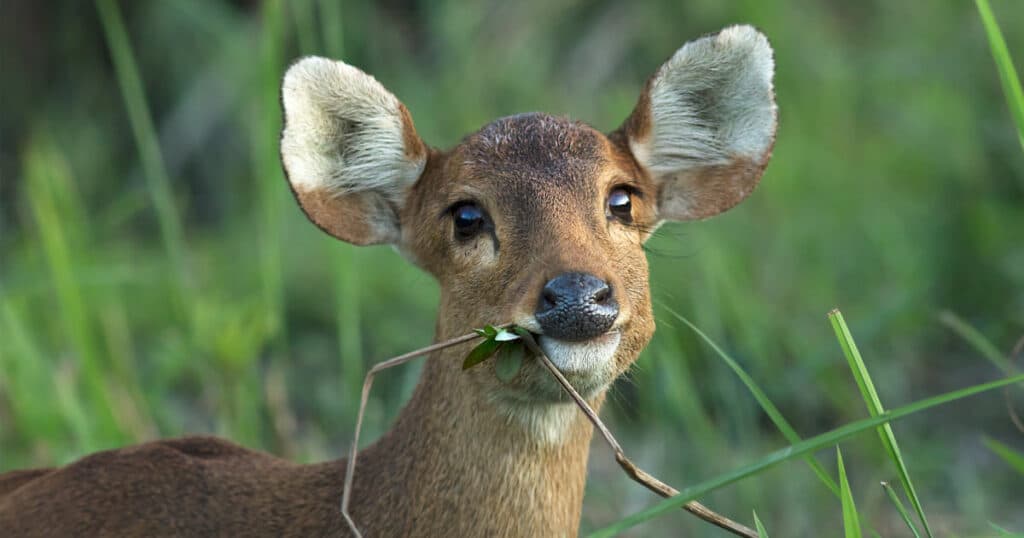The Indian Hog Deer (Cervus porcinus) is a stocky species of deer native to India that now lives in India, Pakistan, and southeastern Asia. It gets its name due to its short, squat appearance, and the unusual way it flees into thick underbrush with its head low when threatened (more reminiscent of a wild pig than a deer).
How Big Are Hog Deer?
- Head & Body Length – 105 to 115 cm
- Shoulder height – 60 to 75 cm
- Tail length – 17 to 21 cm
- Weight – 50 to 110 kg
What Does the Indian Hog Deer Look Like?
The Hog Deer has a rather stocky appearance, having short legs and a muscular body. It is this rather pig like stature resulted in it being given its name of the Hog Deer.
The coat is a dark brownish color. And as is seen in some other Cervid species a dark black stripe runs down the spine from the neck to the base of the tail.
Male hog deer tend to be darker in color than the females. The males grow antlers which have three tines and which grow up to 60 cm in length.
As the Hog Deer is a tropical living species of deer the antlers can be cast and regrown in any season of the year. The tail of Cervus porcinus is of medium length, the upper tail is brown in color, while the under parts are white.
Where do Hog Deer Live?
The Hog Deer is found in northern India and Pakistan. It is also found in parts of southeastern Asia.
Cervus porcinus range and numbers have fallen recently due to over-hunting and habitat loss.
Most populations of Indian Hog Deer are now scattered and only small in number.
The areas in which it prefers to live in are often suitable for human cultivation and settlement, and as the human population in the region has increased, the Hog Deer has disappeared from many places.
Preferred Habitat of Cervus porcinus
The Hog Deer likes areas with good levels of cover near to rivers and marshland.
It can be found in dense reed beds, thick riverside vegetation and close to swamps in woodland.
Indian Hog Deer do not like areas of very thick woodland and forest, even though that is the habitat many deer prefer.
Mating & Reproduction in Hog Deer
The mating season for Cervus porcinus takes place from September to December. Unlike other species of deer the Hog Deer does not try to collect together a harem of females with which to mate, instead Hog Deer mate with a succession of females as they become receptive.
Males fight fiercely using there antlers for the right to breed with females. Only the most dominant males get the chance to breed.
The gestation period for Indian Hog Deer is about 220 to 240 days long, after which a single calf is typically born.
The female gives birth in a concealed location, mostly within thick vegetation. The calf remains hidden, and is visited by the mother to be suckled for the first few weeks of its life. When it is fast enough to run from predators, it begins to accompany the mother.
Indian hog deer fawns are spotted at birth, but these spots fade as the calf grows and matures. The young reach maturity when about a year of age.
Habits and Behavior of the Indian Hog Deer
The Hog Deer is a solitary deer, rarely seen in a herd or groups of any number.
Females may be seen with their young, and males may be seen with females during the rutting period. They spend most of their time hidden in thick vegetation, only emerging during the hours of darkness to feed on various grasses, herbaceous plants and riverside vegetation.
When frightened hog deer emit a whistling alarm call and flee to dense vegetation.
When fleeing they tend to charge into dense vegetation with their head held low, while other species of deer would tend to leap over any obstacle. This strange behavior is more reminiscent of pigs and may also be a reason for its name.


